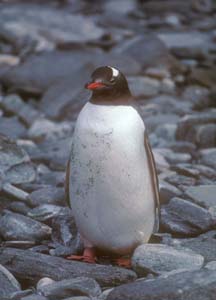 Among the Chinstrap Penguins there were a few Gentoo Penguins,
easily distinguished by their orange feet and white head spots.
Among the Chinstrap Penguins there were a few Gentoo Penguins,
easily distinguished by their orange feet and white head spots.
(Click on any image below for a larger version)
Monday, January 22: Cape Lookout, Elephant Island, page 2
 Among the Chinstrap Penguins there were a few Gentoo Penguins,
easily distinguished by their orange feet and white head spots.
Among the Chinstrap Penguins there were a few Gentoo Penguins,
easily distinguished by their orange feet and white head spots.
Environmental Research Unit, Falkland Islands background information about the Gentoo Penguin.
Background information about the Gentoo Penguin.
 A pair of Macaroni Penguins had taken up a position near the
strait between the spit and the pyramid-shaped island. Macaroni
Penguins belong to the "Crested Penguins", along with Rockhopper Penguins.
A pair of Macaroni Penguins had taken up a position near the
strait between the spit and the pyramid-shaped island. Macaroni
Penguins belong to the "Crested Penguins", along with Rockhopper Penguins.
Background information about the Macaroni Penguin.
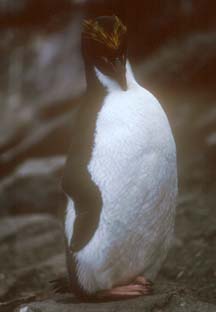 Macaroni Penguins have a crest of yellow feathers that meets over
the forehead.
Macaroni Penguins have a crest of yellow feathers that meets over
the forehead.
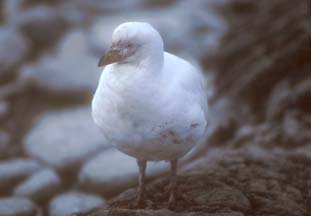 Sheathbills wandered among the penguins, feeding on the rich
supply of guano and other organic material.
Sheathbills wandered among the penguins, feeding on the rich
supply of guano and other organic material.
Link to Britannica.com's page about the Sheathbill.
 A pair of Sheathbills were perched on a high
point, keeping an eye out for an opportunity to get some food.
A pair of Sheathbills were perched on a high
point, keeping an eye out for an opportunity to get some food.
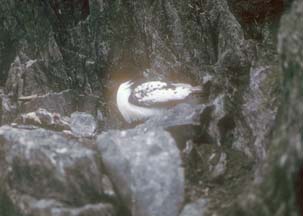 Cape Petrels and Stormy Petrels had built nests
in the stones high above on the rock outcrop. Some of the black
and white petrels could be seen to be sitting on chicks.
Cape Petrels and Stormy Petrels had built nests
in the stones high above on the rock outcrop. Some of the black
and white petrels could be seen to be sitting on chicks.
Link to information about Petrels and other Birds of the Antarctic.
 There were two female Southern Elephant Seals stretched out,
dozing on the cobbles. One of them occasionally lifted her head
and looked around at the troop of photographers and videotape
shooters. She was molting. Old fur was falling out in patches to
be replaced with a new coat.
There were two female Southern Elephant Seals stretched out,
dozing on the cobbles. One of them occasionally lifted her head
and looked around at the troop of photographers and videotape
shooters. She was molting. Old fur was falling out in patches to
be replaced with a new coat.
 The Elephant Seals were less concerned by the uneven, rocky
surface on which they rested than I would have been in similar
circumstances. The rear limbs of "true seals" are of
relatively limited usefulness for moving about on land.
The Elephant Seals were less concerned by the uneven, rocky
surface on which they rested than I would have been in similar
circumstances. The rear limbs of "true seals" are of
relatively limited usefulness for moving about on land.
Link to information about the Southern Elephant Seal at Antarctic Adventure.
Link to information about the Southern Elephant Seal from the Sierra Club Handbook of Seals and Sirenians.
 Antarctic Fur Seals had staked out many
locations in the rookery.
Antarctic Fur Seals had staked out many
locations in the rookery.
Link to information about the Antarctic Fur Seal at Antarctic Adventure.
Jaap van der Toorn has created a page describing the various Fur Seals.
 This seal carefully checked out the beach as it
climbed out of the water.
This seal carefully checked out the beach as it
climbed out of the water.
 Antarctic Fur Seals have external ear flaps,
called pinnae, like those on California Sea Lions.
Antarctic Fur Seals have external ear flaps,
called pinnae, like those on California Sea Lions.
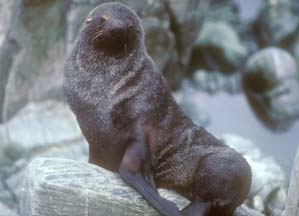 Antarctic Fur Seals have retained greater
function in their rear limbs than the true seals. This allows
them to walk, run, and climb rocks.
Antarctic Fur Seals have retained greater
function in their rear limbs than the true seals. This allows
them to walk, run, and climb rocks.
 Every so often an Antarctic Fur Seal lifted a
flipper or tail fin to scratch an itch.
Every so often an Antarctic Fur Seal lifted a
flipper or tail fin to scratch an itch.
 Several young Antarctic Fur Seals pups slept
near a group of adult female fur seals.
Several young Antarctic Fur Seals pups slept
near a group of adult female fur seals.
 The clouds parted for a little while, allowing the sun to shine
on the Hanseatic.
The clouds parted for a little while, allowing the sun to shine
on the Hanseatic.
After photographing the wildlife on the cape, we were treated to a Zodiac cruise around the craggy island across the strait from the cape.
 The Zodiac driver steered us around the island, just outside the
surf zone, to see where the Macaroni Penguin colonies were
located.
The Zodiac driver steered us around the island, just outside the
surf zone, to see where the Macaroni Penguin colonies were
located.
 .
He nosed the Zodiac toward the shore to allow us to stand in the
center of the boat, one at a time, and shoot pictures of the
penguins.
.
He nosed the Zodiac toward the shore to allow us to stand in the
center of the boat, one at a time, and shoot pictures of the
penguins.
He carefully negotiated the way between the surging water of the inlets and rocky crags jutting out of the water farther offshore.
 The narrow passage that we rode
through was choppy and rough. The water in the inlets rose and
fell over a dozen feet with each wave.
The narrow passage that we rode
through was choppy and rough. The water in the inlets rose and
fell over a dozen feet with each wave.
 Debbie had the front seat in the Zodiac.
Debbie had the front seat in the Zodiac.
Once all the passengers had returned to the ship, it turned south and headed for the Antarctic Peninsula.
 Captain Notke took the time to
cruise along the north coast of Gibbs Island.
Captain Notke took the time to
cruise along the north coast of Gibbs Island.
 A massive cornice of snow was
suspended high above the sea at the top of a dark gray, jagged
cliff.
A massive cornice of snow was
suspended high above the sea at the top of a dark gray, jagged
cliff.
 We then turned around the western
end of the island to cruise along the south coast.
We then turned around the western
end of the island to cruise along the south coast.
 Map of the Antarctic Peninsula.
Map of the Antarctic Peninsula.
 Table of Contents
Table of Contents Send a message to Brian.